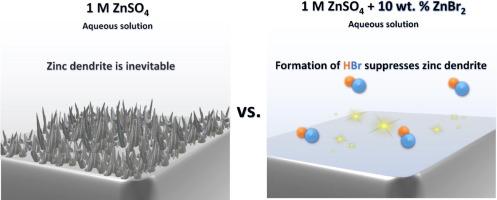Unlocking long-term stability: Electrolyte additives for suppressing zinc dendrite growth in aqueous zinc metal batteries
IF 13.3
1区 工程技术
Q1 ENGINEERING, CHEMICAL
引用次数: 0
Abstract
Aqueous zinc-ion batteries (AZIBs) have attracted great attention for energy storage because of the safety of zinc metal in ambient air. However, the growth of zinc dendrites during repeated electrochemical cycles have hindered their practical use. To address this issue, we introduced ZnBr2 as an additive in an aqueous 1 M ZnSO4 electrolyte, effectively suppressing the dendritic growth on the surface of the zinc-metal anode. Significant improvement in Zn||Zn symmetric cell tests using 10 wt% ZnBr2-added electrolyte was observed, with a lifespan of 12,500 cycles achieved even at a high current density of 50 mA cm−2 with an areal capacity of 1 mAh cm−2. Raman spectroscopy reveals formation of HBr in the electrolyte after 12 h deposition of zinc. The presence of HBr in the electrolyte effectively suppresses the dendritic growth of zinc, as visualized by an operando beaker-cell test and synchrotron tomography. We further demonstrated the compatibility and excellent rate performance of the additive-based electrolyte in Zn || NaV3O8 full cells. Our findings provide a simple and cost-effective method to suppress dendritic growth of zinc in zinc-metal batteries.


开启长期稳定性:抑制锌金属水电池中锌枝晶生长的电解质添加剂
本文章由计算机程序翻译,如有差异,请以英文原文为准。
求助全文
约1分钟内获得全文
求助全文
来源期刊

Chemical Engineering Journal
工程技术-工程:化工
CiteScore
21.70
自引率
9.30%
发文量
6781
审稿时长
2.4 months
期刊介绍:
The Chemical Engineering Journal is an international research journal that invites contributions of original and novel fundamental research. It aims to provide an international platform for presenting original fundamental research, interpretative reviews, and discussions on new developments in chemical engineering. The journal welcomes papers that describe novel theory and its practical application, as well as those that demonstrate the transfer of techniques from other disciplines. It also welcomes reports on carefully conducted experimental work that is soundly interpreted. The main focus of the journal is on original and rigorous research results that have broad significance. The Catalysis section within the Chemical Engineering Journal focuses specifically on Experimental and Theoretical studies in the fields of heterogeneous catalysis, molecular catalysis, and biocatalysis. These studies have industrial impact on various sectors such as chemicals, energy, materials, foods, healthcare, and environmental protection.
 求助内容:
求助内容: 应助结果提醒方式:
应助结果提醒方式:


